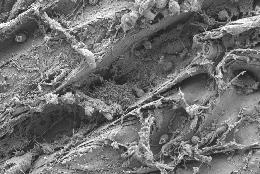In the past sixty years we’ve replaced all the cod with plastic. The floating plastic island in the North Pacific consists of stuff we used once, or not at all, and jettisoned. You can guess what is in it:
- The shrinkwrap packaging from all the junk we bought at dollar stores.
- Our bottles and jars.
- Tampon applicators like the ones I saw washed ashore in Halifax.
- Nylon fishing nets and line.
CAN NATURE CLEAN UP OUR MESS?
There are two factors responsible for the fact that the amount of measurable plastic in the seas seems to be constant. Neither of them has anything to do with us starting to act responsibly; the amount of our plastic pollution increases yearly.
Physical degradation
Plastic is broken down by friction and the bonds in the polymers are cleaved by sunlight. The ocean is full of tiny particles of plastic floating near the surface that we can’t see. There is more of it than plankton in some areas. Sea life is consuming this toxic soup. The chemicals leached from these particles, some of them hormone mimickers, accumulate as they pass up the food chain.
Biological degradation
Gaia is good at adapting, recalibrating homeostasis for the life that she supports. Here’s a heartening report that microorganisms in the oceans are digesting some of the plastic.
 |
| Electron micrograph of bacteria eating a plastic bag from the Sargasso Sea. T. Mincer/G. Proskurowski |
Marine Microbes Digest Plastic
They weren’t able to tell if the polymers were completely broken down. It could be that smaller molecules were released, chemicals that could make their way into the food chain.
CAN WE CLEAN UP OUR OWN MESS?
Unfortunately for us, the way Gaia adapts could take millions of years. In the meantime we’re going to see marine life die from consuming plastic and living in this poisonous water. There are possible technological solutions:
- The Abundant Seas Foundation’s Pod Project. They’ve designed a machine that can filter plastic particles from seawater and sequester them in containers. Pod Project.
- Daniel Burd may have pointed us in the right direction [See link in post below.] We can discover, and engineer if necessary, microorganisms that eat plastic. We then could collect the waste in the oceans, digest it, and release it as mostly CO2 and H2O.
We don’t have a good track record of using technology to fix the mistakes our technologies created. GMOs are an example of how we tried to solve the problems caused by industrial agriculture, namely the destruction of soils and the displacement of indigenous farming practices, by creating more involved technologies. The technology perpetuates the problems, if not making them worse, because it is not a solution to anything but the need to maximize profits.
The technology and the science are neutral; the filters they pass through are not. As long as we use solutions that put profits before all else, we will see useful technologies subverted for monetary gain. It happens every time and we should assume it will happen this time as well. We are approaching desperate times, however and it may be that we have no choice. There is no more out of sight, out of mind because there is, quite simply, nowhere left that is out of sight.
What do you think? Should we use these technologies to clean up the mess we've made?
No comments:
Post a Comment